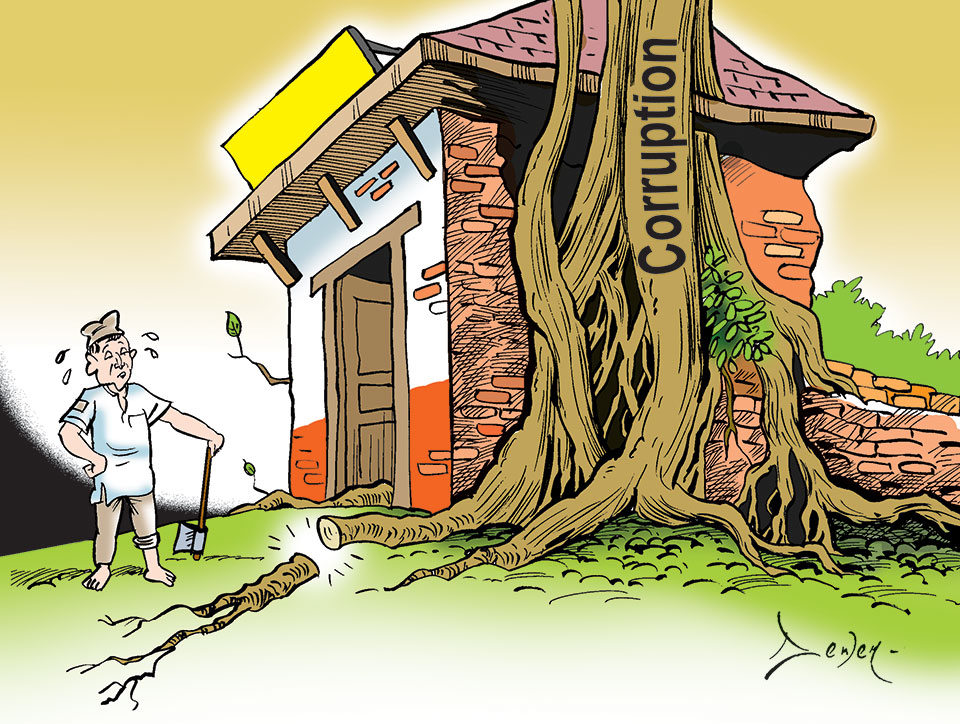
OR
Opinion

There are two ways to control malaria. One, you can have mosquito nets and mosquito repellants. These are essentially preventive measures. Nets and repellants will help keep away mosquitos and prevent you from catching the disease. Second, the most effective way to control malaria is to attack the breeding grounds of the mosquitos. Unless and until you wipe out the breeding grounds, the mosquitos keep on coming. The preventive measures are going to be a temporary solution. You cannot have a sustainable, durable solution to malaria control without attacking the dens of mosquitos.
Similar analogy is used when it comes to fighting corruption. Without attacking the breeding grounds of corruption, no amount of awareness generation programs (education, mass rallies and demonstrations) and preventive measures (administrative reforms) are going to help control corruption. So what lessons can be derived from the malaria eradication program and apply it to controlling corruption? Are corrupt people very much like blood-sucking mosquitos? Before answering these questions, let me clarify a couple of issues that are going around with the anti-corruption protest programs.
Frying small vs. big fishes
Anti-corruption agencies are often charged, this could be true as well, for frying small fishes or controlling petty corruption. They are scared of touching big fishes (grand corruption) because big fishes usually have big friends and that could mean bringing disaster to the agency and the government in power. This debate on frying small vs. big fishes has been going around among the anti-corruption community for a pretty long time. Once former president of Transparency International based in Berlin, Mr. José Ugaz (2014-2017) was asked about this debate on small vs. big fishes. His response was something like this: The issue is not really about big vs. small fishes; it is about whether you have a kitchen to fry fishes, whether your frying pan and the oil is ready to fry fishes. If they are ready you just fry them, you don’t look for big or small fishes. Anti-corruption pundits debate on the relative merits and demerits of frying small vs. big fishes without ever knowing or preparing the frying pan. Let me go back to the question posed earlier.
The Breeding Ground
So if controlling corruption is very much like controlling malaria then we need to shift our attention from frying small vs. big fishes to finding the breeding grounds of corruption and eliminating the same for sustainable results. Again, to drive my points home, let us look into the experience of Hong Kong. Till early 1970s, Hong Kong – then a British colony, used to be a highly corrupt city. Corruption was so rampant that public officials used to declare, “either you get into the bus or run along with the bus; but never-ever dare to stand before the bus.” Because if you stand in front of the moving bus the fate is obvious – you will be killed or maimed. With the establishment of an anti-corruption agency, Hong Kong was transformed from a highly corrupt city to one of the cleanest cities. How was this possible? The agency sought to find the root cause of the problem – the breeding ground of corruption. They discovered that it is the corruption in the police that is corrupting the whole city. And when they dug into police corruption, they found that it was illegal red light areas, gambling houses and drug dealers that were infesting the Hong Kong police. Even till date, the corruption in mainland China is attributed to the Chinese culture of or addiction to gambling. So the clean-up campaign started with cleaning the police corruption plus liberalizing policy with regards to gambling, drug cartels and red-light areas. The Hong Kong anti-corruption agency recruited the best talented people on contract, and paid them high wages (so that they don’t have to dip their hands on moonlightings). Well, it is said that the colonial administration was accountable to none other than British masters, the agency could move on mercilessly. This is another story to tell. But the agency is still regarded as a role model to copy by anti-corruption authorities.
What is the rotting place in Nepal?
Applying the same methods to our case then the question that needs to be asked is: What is the corruption breeding ground in Nepal? Earlier, it used to be or was the then monarchy. Yes, the royal palace was the breeding ground of corruption. The rot was spreading from there and making the whole system corrupt. With the abolition of monarchy, the breeding ground seems to have shifted to somewhere else. Could this be political corruption? What about the corruption in the army, police and security system? More questions can be asked about private sector corruption – the nexus between politics, business and bureaucracy. All grand corruptions tend to reflect that nexus. The on-going investigation into the fake refugee scandal included top-shot political leaders, bureaucrats and manpower dealers fishing on people eager to migrate abroad for income and employment.
If you ask a policy maker in Nepal what is the corruption breeding ground in Nepal they will be hesitant to answer the question. Most probably, they don’t know. This is because we don’t have a culture of doing research. The honchos at the CIAA are so occupied with their files that they don’t even have time to dig into massive doses of information provided by corruption complaints lodged with them on a daily basis. Tens of thousands of corruption complaints provide a kind of gold dust for understanding the rotting place – breeding ground for blood sucking mosquitos.
Keep Your Mouth Shut
The on-going public outrage against corruption, triggered primarily by the fake refugee scandal is going to be of little help other than policy makers looking for a quick fix, temporary, make-shift, patch-up solution. The out-pouring of emotions like “let the corrupt people go to hell”, “hang them at the open-air theater in Tundikhel”, social boycotting and ostracizing will have little effect on controlling corruption. Corruption is fundamentally a rational process that includes deep calculation of costs and benefits, probability of detection, severity of punishment and other factors. Anger and emotions have little room in fighting corruption. An anti-corruption commission in India, established in early 1960s, I suppose the Swaminathan Commission, had suggested that when somebody cries foul against corruption, from his or her rooftop, it gives an impression that the whole society is being corrupted. There is now a special study revealing that it is the “injunctive” anti-corruption statements, not descriptive statements that are helpful in controlling corruption (anybody interested in research findings, please refer to https://www.corruptionjusticeandlegitimacy.org). The basic mantra of fighting corruption is to keep your mouths shut and carry big sticks.
You May Like This

Infographics: Corruption allegations facing Israel’s Benjamin Netanyahu
Israeli police have recommended indicting Benjamin Netanyahu on bribery charges, adding to a catalog of legal troubles that have clouded... Read More...

Corruption
People have worn the garland of greed They want to sleep on the bed of money Are inclined to the... Read More...

Lawmakers seek against all those involved in corruption
KATHMANDU, August 2: Lawmakers have demanded action against all those perpetuating massive financial irregularities while purchasing land plots to build petroleum... Read More...







Just In
- NRB to provide collateral-free loans to foreign employment seekers
- NEB to publish Grade 12 results next week
- Body handover begins; Relatives remain dissatisfied with insurance, compensation amount
- NC defers its plan to join Koshi govt
- NRB to review microfinance loan interest rate
- 134 dead in floods and landslides since onset of monsoon this year
- Mahakali Irrigation Project sees only 22 percent physical progress in 18 years
- Singapore now holds world's most powerful passport; Nepal stays at 98th












Leave A Comment